ARKTOS EXPEDITION / MIKE HORN


After his abandon on Arctic Icepack last spring (2002), South-African Mike Horn
goes on with his
longterm adventure around Arctic Polar Circle
Here are the press communiqués published during the spring 2002
Previous Press Communiqués |
|
February 2003 / 69°24' N 85°29' O / Bear Territory ! 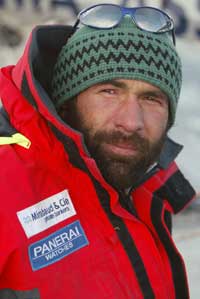
After a long wait in his tent, the weather cleared, visibility became better, and Mike was finally able to move again.
"I have been travelling directly south from Cape Englefield on the sea ice. Nearer the coast the ice is pushed up onto the shore causing huge blocks to build up. This is called the pack ice and some blocks of ice reach up to 7-8 meters high! Getting over these blocks with a heavy sledge is rather tiring. I have averaged about 13kms a day, which is not a lot. One day I was able to use the kite to help pull me over the pack ice. It's amazing the difference it makes. Unfortunately going to shore is not the easiest solution either, because there, I'm greeted with huge cliffs, most of which are impossible to pass. "
"Yesterday I came across open water and with the water of course, there are also the bears! I watched one for a while. a big male fishing for seals. I was upwind from him, so for the time being, knew I was safe. I managed to find a path onto land and knew there was only one route for him to take if he decided to follow me. Luckily he didn't.The further south I go from here the greater the risk I have of meeting up with a few more. I must pitch my tent well away from this open water."
"Am considering crossing westwards over Committee Bay. It's a large area of ocean but seems to be covered with fast ice. This generally means it's okay to cross. I'll be heading south for a few more days and will then decide what I must do." "Good weather for the next few days. I'm happy about that." "Regards to all".
Dispatch 10h January 2003 / Tent and belongings up in smoke !
At 00.15hrs GMT Mike’s tent catches fire and everything inside the tent goes up in smoke. Only ashes remain at Mike’s campsite, position N69°48’830” W086°02’611”
“I wasn't able to do a thing. I was changing the fuel bottle on my stove and on opening the screw top, the fuel sprayed out under high pressure all over the tent. The tiny flame still remaining on the stove was enough to set the whole tent alight in a flash. It ravished everything inside the tent within seconds. 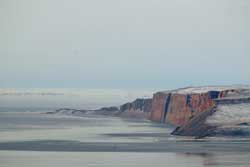 It was so quick the only reaction I had was to save myself! My sledge and its contents are all that I have at present. My sleeping bag went up in smoke, my down jacket, maps, argos, everything that was in my tent! Luckily, my telephone and GPS were safe so I was able to ring my friend in Arctic Bay who has arranged for help to be sent from Igloolik.
It was so quick the only reaction I had was to save myself! My sledge and its contents are all that I have at present. My sleeping bag went up in smoke, my down jacket, maps, argos, everything that was in my tent! Luckily, my telephone and GPS were safe so I was able to ring my friend in Arctic Bay who has arranged for help to be sent from Igloolik.
“I have built an shelter in amongst the pack ice for the evening. It will be a long wait with only a windstopper and a few candles to keep me warm.” “Once back in Igloolik, I will be able to establish the damage and will need to replace everything that I have lost. My logistics team will bring me new equipment next week and I will get moving again as soon as possible.” Twelve hours later, Mike’s help team finally arrives and he is now heading back to Igloolik to assess the damage to his equipment.
Dispatch 26 November 2002 / Mike Horn leaves Arctic Bay - Stage 4 begins!
At midday today (1800hrs GMT), Mike left Arctic Bay – starting his trek across the Northwest Territories of Canada and beginning stage 4 of the Arktos Expedition.
For almost two months, Mike has been blocked in Arctic Bay due to the unusually warm temperatures for this period. Finally, the temperatures over the last two weeks have dropped to a constant -30°C and the ice is slowly thickening.
After speaking with the local Inuit hunters, Mike has decided to head directly south, on land, to the Fury and Hecla Strait. He will regain light hours whilst heading south, allowing him to walk for longer periods during the day before he sets camp in the evening. When he arrives at Fury and Hecla Strait, about one month later, he should be able to traverse safely and arrive on the mainland of Canada. 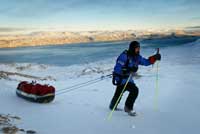 Once on the mainland he will continue westwards, passing Pelly Bay and through to Cambridge Bay.
Once on the mainland he will continue westwards, passing Pelly Bay and through to Cambridge Bay.
There was panic in Arctic Bay yesterday as a polar bear and her cubs walked through the village ransacking rubbish bins and huts in the search food - just one of the many that are in the area and heading in the same direction as Mike. He must remain very attentative and all times and follow the advice of the local people.
"It's sad to leave in Arctic Bay. I have met some wonderful people who have taught me many things about the wildlife and environment. Even so, it's time for me to get going. I'm more ready than ever to continue on my way!!"
Dispatch 11 November 2002 / Mike Horn returns to Arctic Bay...
It’s rather frustrating to have to retrace your footsteps, but given the conditions of the ice Mike had no choice! Mike left Arctic Bay after a huge storm had hit. The sirens in the village had been set off to alert the villagers to stay inside. If they ventured further than their doorstep there was a high chance of being hit by flying debris! 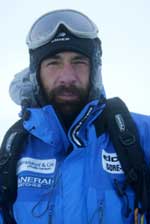
Knowing that the conditions were perfect a few days earlier, Mike was eager to set off. As soon as the wind had calmed, he left. “The strong winds had created pressure ridges on the ice. Some of these broke into huge leads, while in other parts, layers were pushed onto other layers and had become very unstable.”
“There I was with 300 meters of open water in front of me!”
So Mike finds himself back in Arctic Bay. A friend, named Claude, has taken him out around the nearby coastline in search of seals and polar bears. Mike says he has learnt many invaluable things about the nature and environment. “I believe everything happens for a reason so I will wait calmly for the conditions to improve and will try and learn as much as I possibly can in the meantime. Temperatures are once again back up to -15°C (what the locals call a late summer!)
“We just need a few days of really cold weather and no winds and I’ll be able to leave again.”
Dispatch 5 November 2002 / Mike Horn leaves on foot tomorrow
On the 30th of September, Mike moored his boat at Nanisivik, a small mining village off the northern coast of Baffin Island. He had reached the point of no return - behind him the ice was closing up. From Nanisivik, he could now head off on foot, while the boat, ARKTOS, would remain there for the winter. With 5’000 kms of the 20’000 behind him, Mike is now ready for stage 4 of the ARKTOS expedition. This involves the traverse on foot and ski of the North-Western Territories of Canada, heading westwards towards the Bering Strait in Alaska.
“When I arrived in Nanisivik with my boat, there was too much ice to use the kayak, but yet, it was not solid enough to start off on foot, so I had no choice but to wait for a few weeks. This is nature and I must go with it, not against it.”
Mike spent this time preparing for his departure on the ice. ARKTOS has been hauled out of the water and winterised, ready to endure the harsh Northern winter. It will be sailed back to Europe by the logistics team in the spring of 2003, as soon the ice melts and the way is clear. 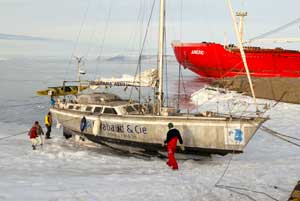
The water in Admiralty Inlet is now frozen and is thick enough to bear Mike’s weight, and the weight of his sledge, heavily laden with equipment and supplies.
The locals have warned him about the polar bears, which use the firmer ice for their southward migration in search of food. They too, are heading for the Prince Regent Inlet, so Mike must remain permanently on the alert. ”Dealing with polar bears will be a bit like dodging ice bergs and growlers. The bears move along the fringes of the land, taking their food from the water. I’ll have to stay clear of these areas as much as I can. I’ll camp on higher ground, away from the water at night. I’ll also have to set up my ‘bear watch’ system and must be extra careful with storing my food, and when cooking.”
Mike often feels a deep sense of privilege to be doing what he does for a living – “I have nothing, but what I have experienced, nobody can take away from me.” He feels gratitude to those who have helped him, in big ways and small, to live his dream.
Dispatch 13 September 2002 / Mike Mike Horn completes the traverse of Greenland
– 2nd stage completed.
A great day today as Mike completes the traverse of Greenland on skis. He arrived at his boat at Disko Bay, on the West coast, at 2130hrs GMT - only 17 days after his departure from the East coast.
He reports, “It was tough going at the beginning. I was lucky to find a route to take me up the 3000m of altitude onto the ice cap. My sledge was laden with about 100kgs of equipment including minimal rations of food. Bad weather moved in just as I arrived on the ice cap and the strong winds, thick snow and bitter cold temperatures made my progression extremely difficult. All the odds seemed to be continuously against me and I was forced to seek refuge for two days in the tent because of the whiteout conditions.”
After this bad start conditions slowly started to improve. “The winds turned and I was able to use the kite to pull me on my skis. What a pleasure to get speed at long last! With the kite I could easily cover 60kms in a day. My record day was 143 kms. The more ground I covered in the day, the more food I could eat as well, so that was a great bonus.”
Once reaching the coast Mike was greeted by the boat and crew members. Jean-Philippe Patthey, Pierre-Yves Martin, Angelo Guarino and Dominique Billieux sailed the boat around the southern tip of Greenland and up the west coast to await the arrival of Mike.
After a few days of rest Mike will say goodbye to his crew - stage 3 will commence - sailing westwards - destination Canada.
Dispatch 18th august 2002 / Mike Mike arrives at Greenland
- Stage 1 completed
At 1600hrs on the 17th of August Mike arrived at the port of Angmagssalik on the eastern coast of Greenland. Angmagssalik, a small Inuit village of 1200 inhabitants is equiped with airport and port and is where logistics crew were able to meet him. 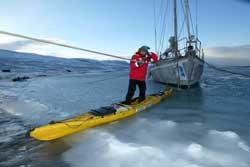
A few days ago Mike noticed water leaking into the hull of the boat."Not a major problem but inconvenient because it means I will need to work a few days on the boat before I can head off again. It could get worse so it must be fixed."
"The last few days were stressful. Huge icebergs started appearing and then the fog came in. I couldn't see 5 meters in front of me. I didn't sleep for 4 days - it would have been too risky. The icebergs are massive. I've never seen anything like it before. It's amazing to see!"
The traverse of the Greenland Sea from the North Cape until the east coast of Greenland took 13 days with northwesterly winds and an average speed of 6-9 knots. At the beginning Mike had to stop and change the position of the compass. The automatic pilot was not functioning correctly and Mike eventually realised it was a magnetic field around the compass which was causing the automatic pilot to veer to the left. Luckily the problem was quickly resolved and he was able to continue on his way.
Mike will be leaving again in a few days. Angmagssalik is situated at the mouth of a large fjord. Mike will ascend this fjord and find a place where he will be able to get onto the icecap. He will need to ascend the glacial walls which fall into the ocean. "They are a face of sheer ice so it may take a while to find a good passage."
Once on the ice cap Mike hopes the traverse will be relatively smooth. Due to cold temperatures the ice conditions are apparently good and if weather permits he will be able to use a kite to help pull him along. Logistics crew will sail the boat to the west coast where they will meet up with Mike once again after his traverse of Greenland.
Dispatch 4th August 2002 / Around the world solo via the Arctic Circle / The adventurer Mike Horn set sail on Sunday for North Cape / Berne/ Honningsvag (ats)
The adventurer Mike Horn set sail on Sunday in the direction of North Cape in rough seas. After his first attempt in April was aborted on account of serious frostbite, Mike is again setting out to go around the world alone following the Arctic Circle. He said goodbye to this wife Cathy, his two daughters aged eight and ten, and his friends. At around 15.15 hrs, the adventurer crossed the line for North Cape. Around 25 people, including the seven members of his supply team accompanied him to Honningsvag, in Norway, some thirty kilometres from North Cape.
"It's always very hard to see him leave," his wife Cathy Horn commented as he departed. But this time the weather conditions are good. "It's around fifteen degrees, whereas in February, Mike experienced temperatures of minus forty," she stated. His team of companions toasted him with champagne to wish him good luck. The adventurer will be sailing his 14-metre single-hull aluminium boat for between two and four weeks. The boat was designed specially for the expedition. When he encounters the first ice, he will continue his journey on foot and the boat will be recovered by his.
His 20 000 km "walk" in the Arctic will take him from Greenland, to Canada, across Alaska and Siberia. His expedition amid the ice, cold, wind and polar bears will last about 18 months.
During his trip, Mike Horn will be using various methods of transport in addition to his mono-hull. To cross the lakes and marshes, he will make his way aboard a sea-going kayak, which can also be used as a sledge on ground that is covered with snow or ice.
The globe-trotter is also equipped with skis and a special sledge made from Kevlar, in which he will carry his equipment. He will be taking a total load of approximately 200 kilos. If conditions are good, he has a type of traction kite with him to pull him along and relieve him of the weight of the sledge.
At each of the eleven stopping points along the way, Mike Horn will have the support of his logistics team who will join him to check his equipment as well as re-supply him with food, batteries and medicines. These stop-off points will also be used to take photographs and shoot a film tracing his journey.
Second attempt
Called "Arktos", the solo expedition set off at the end of February 2002, but had to be interrupted at the beginning of April. Suffering from serious frostbite to his hands, the adventurer was taken back to hospital at Chamonix in France, then on to the Pays d'En-Haut, where he usually lives.
Mike Horn, 35, was born in Johannesburg in South Africa. After studying human sciences, he came to live in Europe in 1990, where he worked as a ski instructor and rafting guide, as well as a canyoning specialist. He organised his first paragliding and rafting expedition to Peru in 1991.




 It was so quick the only reaction I had was to save myself! My sledge and its contents are all that I have at present. My sleeping bag went up in smoke, my down jacket, maps, argos, everything that was in my tent! Luckily, my telephone and GPS were safe so I was able to ring my friend in Arctic Bay who has arranged for help to be sent from Igloolik.
It was so quick the only reaction I had was to save myself! My sledge and its contents are all that I have at present. My sleeping bag went up in smoke, my down jacket, maps, argos, everything that was in my tent! Luckily, my telephone and GPS were safe so I was able to ring my friend in Arctic Bay who has arranged for help to be sent from Igloolik.  Once on the mainland he will continue westwards, passing Pelly Bay and through to Cambridge Bay.
Once on the mainland he will continue westwards, passing Pelly Bay and through to Cambridge Bay.

